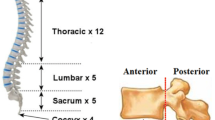Abstract
The spinal column is one of the crucial parts of the human anatomy and the essential function of this column is the protection of the spinal cord. Each part of the individual bones to compose the spinal column is called vertebra. Vertebral compression fracture is one of the types of fractures that occur in the spinal column. This fracture type causes loss of bone density alongside with pain and loss of mobility. In recent years, image processing is an effective tool that is widely used in the analysis of medical images. In this study, a novel system is proposed for the detection of vertebral body compression fracture using spine CT images. The sagittal plane is used in these CT images. For the detection of the fracture, the heights of the longest and shortest heights of the vertebral bodies are measured using image processing techniques. The aim of this study is to develop an automated system to help radiology specialists by facilitating the process of vertebral fracture diagnosis. The proposed system detected the fractured vertebrae successfully in all images that are used in this study.
Access this chapter
Tax calculation will be finalised at checkout
Purchases are for personal use only
Similar content being viewed by others
References
University of Maryland Medical Center. https://www.umms.org/ummc/healthservices/orthopedics/services/spine/patient-guides/anatomy-function . Accessed 22 July 2018
Esses, S.I., McGuire, R., Jenkins, J., Finkelstein, J., Woodard, E., Watters, W.C., Goldberg, M.J., Keith, M., Turkelson, C.M., Wies, J.L., Sluka, P.: The treatment of osteoporotic spinal compression fractures. J. Bone Joint Surg. Am. 93(20), 1934–1936 (2011)
Radiopaedia. https://radiopaedia.org/articles/osteoporotic-spinal-compression-fracture. Accessed 30 July 2018
Klinder, T., Ostermann, J., Ehm, M., Franz, A., Kneser, R., Lorenz, C.: Automated model-based vertebra detection, identification, and segmentation in CT images. Med. Image Anal. 13(3), 471–482 (2009)
Patrick, J., Indu, M.G.: A semi-automated technique for vertebrae detection and segmentation from CT images of spine. In: International Conference on Communication Systems and Networks (ComNet), pp. 44–49. IEEE, July 2016
Barbieri, P.D., Pedrosa, G.V., Traina, A.J.M., Nogueira-Barbosa, M.H.: Vertebral body segmentation of spine MR images using superpixels. In: 28th International Symposium on Computer-Based Medical Systems. Institute of Electrical and Electronics Engineers–IEEE (2015)
Ghosh, S., Raja’S, A., Chaudhary, V., Dhillon, G.: Automatic lumbar vertebra segmentation from clinical CT for wedge compression fracture diagnosis. In: Medical Imaging 2011: Computer-Aided Diagnosis, vol. 7963, p. 796303. International Society for Optics and Photonics, March 2011
Dhawan, V., Sethi, G., Lather, V.S., Sohal, K.: Power law transformation and adaptive gamma correction: a comparative study. Int. J. Electron. Commun. Technol. 4(2), 118–123 (2013)
Senthilkumaran, N., Vaithegi, S.: Image segmentation by using thresholding techniques for medical images. Comput. Sci. Eng.: Int. J. 6(1), 1–13 (2016)
Abinaya, G., Banumathi, R., Seshasri, V., Kumar, A.N.: Rectify the blurred license plate image from fast moving vehicles using morphological process. In: IEEE International Conference on Electrical, Instrumentation and Communication Engineering (ICEICE 2017), pp. 1–6. IEEE, April 2017
Saikumar, T., Yugander, P., Murthy, P.S., Smitha, B.: Image segmentation algorithm using watershed transform and fuzzy C-Means clustering on level set method. Int. J. Comput. Theor. Eng. 5(2), 209 (2013)
Soille, P.: Texture analysis. In: Morphological Image Analysis, pp. 317–346. Springer, Heidelberg (2004)
Gonzalez, R.C., Woods, R.E.: Digital Image Processing. Pearson Prentice Hall, Upper Saddle River (2008)
Ilhan, U., Ilhan, A.: Brain tumor segmentation based on a new threshold approach. Proc. Comput. Sci. 120, 580–587 (2017)
Dantzig, G.B., Thapa, M.N.: Linear Programming 1: Introduction. Springer, Heidelberg (2006)
European Society of Radiology. https://posterng.netkey.at/esr/viewing/index.php?module=viewing_poster&task=viewsection&pi=114839&si=1166&searchkey=. Accessed 21 July 2018
Author information
Authors and Affiliations
Corresponding author
Editor information
Editors and Affiliations
Rights and permissions
Copyright information
© 2020 Springer Nature Switzerland AG
About this paper
Cite this paper
İlhan, A., Kaba, Ş., Kneebone, E. (2020). Vertebral Body Compression Fracture Detection. In: Arai, K., Kapoor, S. (eds) Advances in Computer Vision. CVC 2019. Advances in Intelligent Systems and Computing, vol 943. Springer, Cham. https://doi.org/10.1007/978-3-030-17795-9_26
Download citation
DOI: https://doi.org/10.1007/978-3-030-17795-9_26
Published:
Publisher Name: Springer, Cham
Print ISBN: 978-3-030-17794-2
Online ISBN: 978-3-030-17795-9
eBook Packages: Intelligent Technologies and RoboticsIntelligent Technologies and Robotics (R0)




